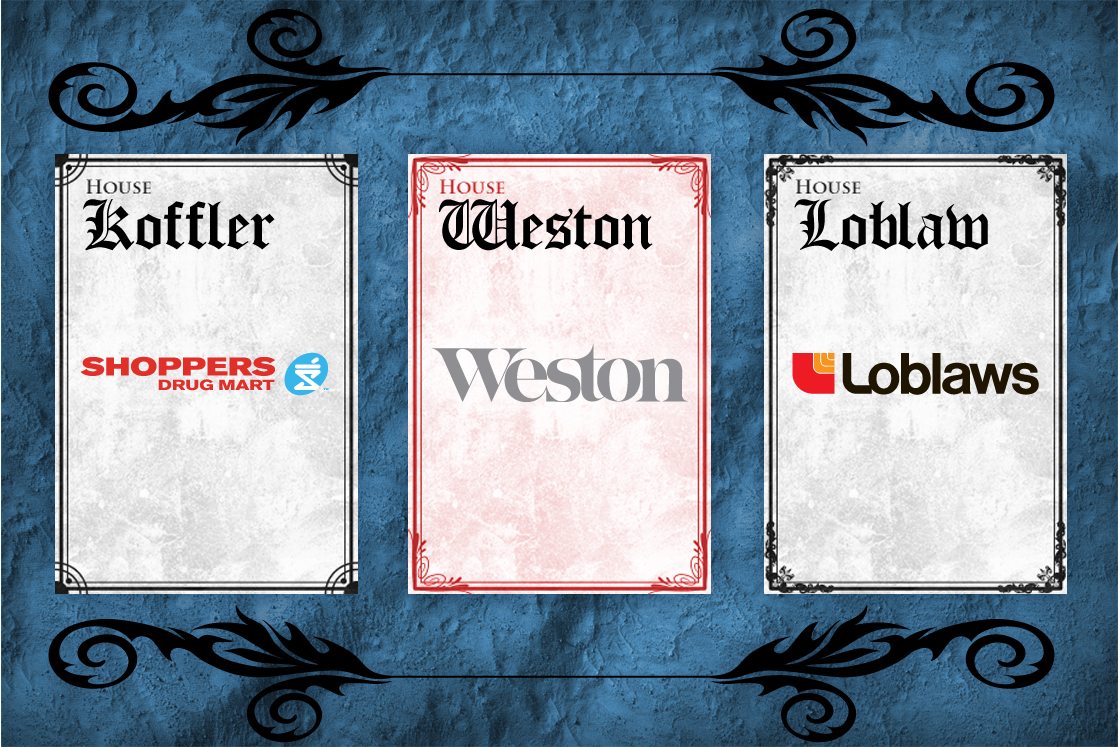TORONTO – Subject to necessary approvals, Loblaw Cos. Ltd. intends to purchase Shoppers Drug Mart Corp. for a colossal $12.4 billion, meaning Canadians may soon shop for groceries, sundry items, medicine and everything in between at thousands of stores owned by the country’s richest retail dynasty: the Westons.

The proposed merger would be the latest and richest development in what can be described as a “Game of Thrones”-like saga of the Canadian retail sector that has been over a century in the making, and whose lineage can be traced back to three families – The Loblaws, Westons and Kofflers.
Humble Toronto beginnings
All three of what would become some of Canada’s most recognized retail store brands originated in Toronto.
Theodore Pringle Loblaw travelled from Alliston, Ont., to Toronto with $30 in his pocket in search of a job. After landing work at Cork’s Cash Grocery (located at 400 King Street East), he struck up a friendly and professional relationship with the owner, J. Milton Cork.
In 1900, he and Cork purchased an interest in a second grocery store. However, the first Loblaw Groceterias, which incorporated a cheap, convenient, self-serve system inspired by grocery stores he had seen in the U.S., opened in 1919.
In 1882, George Weston purchased a bread route from his employer. Weston, who was born in New York but whose family originated in Ontario, had previously worked as a baker’s apprentice in Toronto. He was one of the first bakers to begin modernizing the baking process by using state-of the-art technology, such as mechanical mixers. Soon after building his Model Bakery in 1897, he was producing more bread than any other single baker in Canada.
Murray Koffler took over his father’s Toronto pharmacies in 1941. He opened the first Shoppers Drug Mart in 1962. He conceptualized the “Associate Concept” model, which allowed pharmacists to be independent business owners while still having the support of a larger infrastructure and not sacrifice the personal touch of existing community pharmacists.
Map: Original Storefronts
Tragedy, succession, and acquisition
By 1928, Loblaw Grocerterias Company Limited had expanded across Ontario as well as into New York State, Pennsylvania and Chicago, with 800 employees. Loblaw passed away during a routine surgery in 1933.
Nine years earlier, George Weston had passed away from a stroke, and was succeeded by his son, Garfield Weston. He was able to weather the Great Depression, emerging as a successful purveyor of English-style biscuits and loaves of bread with factories in Canada, the U.S. and the U.K.
In 1947, Weston acquired 100,000 units of Loblaw stock from surviving co-founder J. Milton Cork, gaining majority stake in the company by the early 1950s. Loblaw Companies Limited was incorporated in 1956, consolidating the Canadian and U.S. Loblaw chains.
Shoppers grows while Loblaw slows
Meanwhile, Koffler’s “Associate Model” became a hit, and Shoppers’ began a period of rapid acquisition and expansion, including the acquisition of Cunningham Drug Stores located in B.C. and Alberta, as well as the establishment of the first Pharmaprix in Quebec in 1972.
That same year, Loblaw was on the verge of bankruptcy. It was losing in a battle with Dominion, which had actually originated as the group of grocery stores owned by Loblaw and Cork prior to 1919.
Loblaw rises from the ashes
Galen Weston, Garfield Weston’s son, became CEO of Loblaw in 1972. He immediately downsized the company by closing half of its locations, and renovating and modernizing the rest.
This – coupled with a strong focus on marketing, brand and product development (Such as President’s Choice and No Name) – saved Loblaw from the brink of death.
WATCH: A vintage Loblaw commercial featuring William Shatner
Shoppers Drugmart continued growing throughout the late 20th century and into the next. It introduced the now-ubiquitous Shopper’s Optimum card in 2000, was listed on the Toronto stock exchange in 2001, and opened its first large format store in 2002.
Timeline: Key Conquests (Shoppers)
Shoppers Drug Mart is no slouch when it comes to the acquisitions and mergers game. Much of the company’s expansion over the past 51 years can be attributed to the acquisition of competitors across the country.
- 1968 – Purchases 33 Plaza Drug Stores (Ontario)
- 1971 – Purchases 87 Cunningham Drug Stores (Alberta/BC)
- 1995 – Purchases 135 Big V Department Stores (Ontario)
- 2006 – Acquires Medisystem Technologies Inc.
- 2008 – Acquires the Health Access Division of Calea Ltd., (which becomes the Shoppers Drug Mart Speciality Health Network Inc.)




Comments